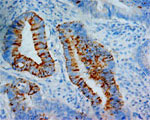Intercellular adhesion molecule 1 (ICAM1), Rabbit Polyclonal Antibody
Only %1 left
Catalog Number
R-1025
Discontinued
- Product Name Intercellular adhesion molecule 1 (ICAM1), Rabbit Polyclonal Antibody
- Product Description Rabbit anti-Intercellular adhesion molecule 1 (ICAM1) Polyclonal Antibody (Unconjugated), suitable for WB, IHC-Frozen, IHC-Paraffin-embedded.
- Alternative Names ICAM1; ICAM-1; Intercellular adhesion molecule 1; CD54;
- Application(s) IHC-Frozen, IHC-Paraffin-embedded, WB
- Antibody Host Rabbit
- Antibody Type Polyclonal
- Specificity The specificity of this antibody has been confirmed by WB and IHC against the antigen. Human
- Species Reactivity Human
- Immunogen Description A synthetic peptide (YNRQRKIKKYRLQQ) corresponding to a region (503-516) from the C-terminus of human ICAM1.
- Conjugate Unconjugated
- Purity Description Affinity purified on antigen column
- Regulatory Status For research use only.
Product Info
- Product Description Rabbit anti-Intercellular adhesion molecule 1 (ICAM1) Polyclonal Antibody (Unconjugated), suitable for WB, IHC-Frozen, IHC-Paraffin-embedded.
- Application(s) IHC-Frozen, IHC-Paraffin-embedded, WB
- Application Details Immunohistochemistry (IHC) and Western Blotting (WB). A concentration of 0.1-0.5 µg/mL is recommended for WB. Human ICAM1 (precursor) has a predicted length of 532 residues and a MW of 58 kDa. A concentration of 0.5-1 µg/mL is recommended to detect ICAM1 in formalin fixed and paraffin embedded tissues. Heat mediated antigen retrieval is recommended. Biosensis recommends optimal dilutions/concentrations should be determined by the end user.
- Target Intercellular adhesion molecule 1 (ICAM1)
- Specificity The specificity of this antibody has been confirmed by WB and IHC against the antigen. Human
- Target Host Species Human
- Species Reactivity Human
- Antibody Host Rabbit
- Antibody Type Polyclonal
- Antibody Isotype IgG
- Conjugate Unconjugated
- Immunogen Description A synthetic peptide (YNRQRKIKKYRLQQ) corresponding to a region (503-516) from the C-terminus of human ICAM1.
- Purity Description Affinity purified on antigen column
- Format Lyophilized with 5 mg BSA, 0.9 mg NaCl, 0.2 mg Na2HPO4, 0.05 mg Thimerosal, 0.05 mg NaN3
- Reconstitution Instructions Spin vial briefly before opening. Reconstitute in 100 µL sterile-filtered, ultrapure water to achieve an antibody concentration of 1 mg/mL. Centrifuge to remove any insoluble material.
- Storage Instructions At least 12 months after purchase at 2-8°C (lyophilized formulations). After reconstitution, aliquot and store at -20°C for a higher stability. Avoid freeze-thaw cycles
- Batch Number Please see item label.
- Expiration Date 12 months after date of receipt (unopened vial).
- Alternative Names ICAM1; ICAM-1; Intercellular adhesion molecule 1; CD54;
- Uniprot Number P05362
- Uniprot Number/Name P05362 (ICAM1_HUMAN)
- Scientific Background Intercellular adhesion molecule 1 (ICAM1) is a single-pass type 1 membrane glycoprotein that belongs to the ICAM family. ICAM1 is typically expressed on endothelial cells and cells of the immune system. ICAM-1 is also expressed in all types of glial cells including astrocytes and microglia.
- Shipping Temperature 25°C (ambient)
- UNSPSC CODE 41116161
- Regulatory Status For research use only.
Specifications
-
General References
Satoh J. et al. Cytokine-induced expression of intercellular adhesion molecule-1 (ICAM-1) in cultured human oligodendrocytes and astrocytes. J Neuropathol Exp Neurol. 1991 May;50(3):215-26.
Verbeek M.M. Accumulation of intercellular adhesion molecule-1 in senile plaques in brain tissue of patients with Alzheimer's disease. Am J Pathol. 1994 January; 144(1): 104-11
Heppner F.L. et al. Vitamin E induces ramification and downregulation of adhesion molecules in cultured microglial cells. Glia. 1998 Feb;22(2):180-8.
Yang Y. et al. Evaled expression of ICAM-1 and its ligands in the rat spinal cord following lipopolysaccharide intraspinal injection. Neuromolecular Med. 2008;10(4):385-9

 1800 605-5127
1800 605-5127 +61 (0)8 8352 7711
+61 (0)8 8352 7711

